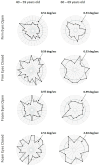Evaluation of Sensory and Motor Function in Spinal and Bulbar Muscular Atrophy Using Quiet Stance and Reactive Postural Control
- PMID: 40559318
- PMCID: PMC12196303
- DOI: 10.3390/neurolint17060079
Evaluation of Sensory and Motor Function in Spinal and Bulbar Muscular Atrophy Using Quiet Stance and Reactive Postural Control
Abstract
Introduction: Spinal and bulbar muscular atrophy (SBMA) is an X-linked neuromuscular disorder characterized by progressive muscle weakness, along with muscle cramps, tremors, and sensory neuropathy. Previous research has shown that patients with SBMA have difficulty with dynamic balance and sensory postural control during quiet stance. There have been no reports on automatic postural reactions in SBMA.
Objectives: In this study, we aimed (1) to augment previous findings of sensory postural control, (2) to investigate automatic postural reactions in SBMA, and (3) to explore the relationship between strength and balance.
Design: A cross-sectional design was used for the analysis.
Participants: The participants were fifty male individuals with a confirmed diagnosis of SBMA.
Outcome measures: Balance testing included the NeuroCom modified Clinical Test of Sensory Interaction on Balance (mCTSIB), which measures sway velocity during quiet stance, and the NeuroCom Motor Control Test (MCT), which measures the latency and strength of postural reactions following sudden perturbations. Strength testing included maximal voluntary isometric contractions measured via fixed-frame dynamometry.
Results: Forty-seven out of fifty participants were able to complete the mCTSIB test, but only thirty-eight completed the MCT test. Patients who were unable to complete the MCT were significantly weaker in all lower extremity muscles compared to those who were able to complete testing. Compared to normative data, participants showed significantly higher sway velocity during quiet stance across all conditions of the mCTSIB, except when standing on foam with eyes open. They also exhibited significantly slower postural reactions in response to sudden shifts of the force plate on the MCT. Plantarflexor weakness was significantly correlated with poor postural control on the mCTSIB and MCT.
Conclusions: This study confirms previously reported abnormalities of sensory postural control in SBMA and highlights patients' heavy reliance on visual inputs for postural control. Additionally, this study shows that automatic postural corrections are slower than normal in SBMA and provides a unique approach for measuring the combined sensory and motor components of the disease. Both the sensory and automatic balance abnormalities were found to be associated with plantarflexor weakness and may contribute to a higher risk of falls under challenging situations. Therefore, addressing this weakness may be an important step toward fall prevention in this population.
Keywords: Kennedy’s Disease; Spinal Bulbar Muscular Atrophy; automatic postural reflexes; balance; posturography; sensory postural control; strength.
Conflict of interest statement
The authors declare that there are no conflicts of interest regarding the publication of this paper. The views, information or content, and conclusions presented do not necessarily represent the official position or policy of, nor should any official endorsement be inferred on the part of, the Clinical Center, the National Institutes of Health, or the Department of Health and Human Services.
Figures


Similar articles
-
Identifying Clinical Measures Related to Falls in Ambulatory Patients with Spinal and Bulbar Muscular Atrophy.Neurol Int. 2025 May 23;17(6):80. doi: 10.3390/neurolint17060080. Neurol Int. 2025. PMID: 40559319 Free PMC article.
-
Sertindole for schizophrenia.Cochrane Database Syst Rev. 2005 Jul 20;2005(3):CD001715. doi: 10.1002/14651858.CD001715.pub2. Cochrane Database Syst Rev. 2005. PMID: 16034864 Free PMC article.
-
Systemic pharmacological treatments for chronic plaque psoriasis: a network meta-analysis.Cochrane Database Syst Rev. 2017 Dec 22;12(12):CD011535. doi: 10.1002/14651858.CD011535.pub2. Cochrane Database Syst Rev. 2017. Update in: Cochrane Database Syst Rev. 2020 Jan 9;1:CD011535. doi: 10.1002/14651858.CD011535.pub3. PMID: 29271481 Free PMC article. Updated.
-
Comparison of cellulose, modified cellulose and synthetic membranes in the haemodialysis of patients with end-stage renal disease.Cochrane Database Syst Rev. 2001;(3):CD003234. doi: 10.1002/14651858.CD003234. Cochrane Database Syst Rev. 2001. Update in: Cochrane Database Syst Rev. 2005 Jul 20;(3):CD003234. doi: 10.1002/14651858.CD003234.pub2. PMID: 11687058 Updated.
-
Systemic pharmacological treatments for chronic plaque psoriasis: a network meta-analysis.Cochrane Database Syst Rev. 2021 Apr 19;4(4):CD011535. doi: 10.1002/14651858.CD011535.pub4. Cochrane Database Syst Rev. 2021. Update in: Cochrane Database Syst Rev. 2022 May 23;5:CD011535. doi: 10.1002/14651858.CD011535.pub5. PMID: 33871055 Free PMC article. Updated.
Cited by
-
Identifying Clinical Measures Related to Falls in Ambulatory Patients with Spinal and Bulbar Muscular Atrophy.Neurol Int. 2025 May 23;17(6):80. doi: 10.3390/neurolint17060080. Neurol Int. 2025. PMID: 40559319 Free PMC article.
References
-
- Shrader J.A., Sansare A., Shieh V., Woolstenhulme J.G., Rekant J., Jiménez-Silva R., Joe G.O., Kokkinis A., Fischbeck K.H., Grunseich C., et al. Dynamic Balance in Spinal and Bulbar Muscular Atrophy: Relationship between Strength and Performance of Forward Lunge, Step Up and Over, and Step Quick Turn. Rehabil. Res. Pract. 2021;2021:2540324. doi: 10.1155/2021/2540324. - DOI - PMC - PubMed
LinkOut - more resources
Full Text Sources

